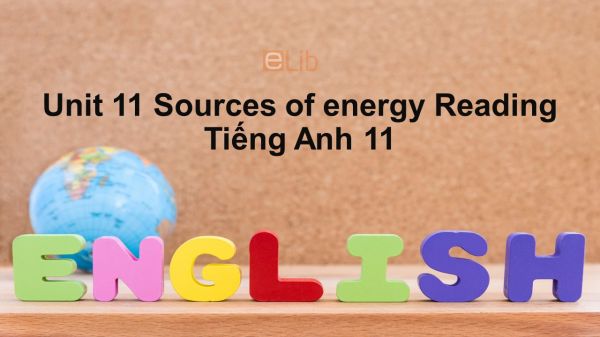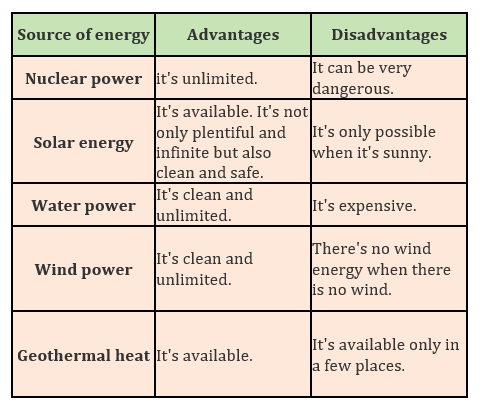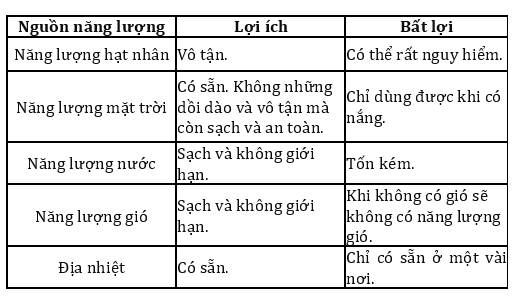Unit 11 lớp 11: Sources of energy-Reading
Bài học Unit 11 lớp 11 "Sources of energy" phần Reading rèn luyện kỹ năng đọc lướt để nắm thông tin bài tổng quát. Qua đó, mang đến nội dung về nguồn năng lượng thay thế trong thiên nhiên.
Mục lục nội dung

1. Before You Read Unit 11 lớp 11
Work in pairs. Answer the following questions
(Làm việc theo cặp. Trả lời các câu hỏi sau)
1. What source of enerey does each picture above refer to?
2. What do we need eneray for?
Guide to answer
1. Each picture refer to: Wind energy, Solar energy and Water energy
2. We need energy to cook, to light, to heat or cool the house and to run machines, ...
Tạm dịch
1. Mỗi bức tranh trên đề cập đến nguồn năng lượng nào?
Mỗi bức tranh trên đề cập đến: năng lượng gió, năng lượng mặt trời, năng lượng nước
2. Chúng ta cần năng lượng để làm gì?
Chúng ta cần năng lượng để nấu nướng, để chiếu sáng, để sưởi ấm hoặc làm mát nhà cửa và để vận hành máy móc…
2. While You Read Unit 11 lớp 11
Read the passage and then do the tasks that follow (Đọc kĩ đoạn văn và sau đó làm các nhiệm vụ tiếp theo)
At present, most of our energy comes from fossil fuels (oil, coal, and natural gas). However, such reserves are limited. Because power demand is increasing very rapidly, fossil fuels will be exhausted within a relatively short time. Therefore, people must develop and use alternative sources of energy.
One alternative source is nuclear energy. Nuclear energy can provide enough electricity for the world’s needs for hundreds of years, but it can be very dangerous. Another alternative source of energy is geothermal heat, which comes from deep inside the earth. Scientists use this heat to make energy. However, this energy is available only in a few places in the world.
The sun, water, and the wind are other alternative sources of energy. The wind turns windmills and moves sailboats. It is a clean source of energy, and there is lots of it. Unfortunately, if the wind does not blow, there is no wind energy. When water moves from a high place to a lower place, it makes energy. This energy is used to create electricity. Water power gives energy without pollution. However, people have to build dams to use this energy. And as dams cost a lot of money, water energy is expensive.
The sun releases large amounts of energy every day. This energy can be changed into electricity. Many countries use solar energy for their daily life. Solar panels on the roofs of houses can create enough energy to heat or cool an entire house. Solar energy is not only plentiful and infinite but also clean and safe.
Although there are some disadvantages, the potential of alternative sources of energy is great. However, how to make full use of these sources of energy is a question for researchers all over the world.
Tạm dịch
Hiện nay, hầu hết năng lượng của chúng tôi đến từ nhiên liệu hóa thạch (than, dầu và khí tự nhiên). Tuy nhiên, dự trữ còn hạn chế. Bởi vì nhu cầu điện đang tăng rất nhanh, nhiên liệu hóa thạch sẽ cạn kiệt trong một thời gian tương đối ngắn. Vì vậy, ngườì ta phải phát triển và sử dụng các nguồn năng lượng thay thế.
Một nguồn năng lượng thay thế là nguồn năng lượng hạt nhân. Năng lượng hạt nhân có thể cung cấp đủ điện cho các nhu cầu của thế giới trong hàng trăm năm, nhưng nó có thể rất nguy hiểm. Một nguồn năng lượng thay thế là địa nhiệt đến từ sâu bên trong trái đất. Các nhà khoa học sử dụng nhiệt để tạo ra năng lượng. Tuy nhiên, năng lượng này chỉ có ở một vài nơi trên thế giới.
Mặt trời, nước và gió là những nguồn năng lượng thay thế khác. Gió quay cối xay gió và di chuyển thuyền buồm. Đó là một nguồn năng lượng sạch và có rất nhiều. Thật không may, nếu gió không thổi thì cũng không có năng lượng gió. Khi nước di chuyển từ một nơi cao đến nơi thấp hơn, nó làm ra năng lượng. Tuy nhiên con người phải xây đập nước để sử dụng nguồn năng lượng này. Xây đập tốn rất nhiều tiền, vì vậy năng lượng nước cũng đắt đỏ.
Mặt trời giải phóng một lượng lớn năng lượng mỗi ngày. Năng lượng này có thể được chuyển hóa thành điện năng. Nhiều quốc gia sử dụng năng lượng mặt trời cho cuộc sống hằng ngày của họ. Tấm pin mặt trời trên mái nhà có thể tạo ra đủ năng lượng để sưởi ấm hoặc làm mát toàn bộ ngôi nhà. Năng lượng mặt trời không chỉ phong phú và vô hạn mà còn sạch sẽ và an toàn.
Mặc dù có một số nhược điểm, tiềm năng của các nguồn năng lượng thay thế là rất lớn. Tuy nhiên, làm thế nào để có thể tận dụng triệt để các nguồn năng lượng là một câu hỏi dành cho các nhà nghiên cứu trên toàn thế giới.
2.1. Task 1 Unit 11 lớp 11
The words in the box all appear in the passage. Fill each blank with a suitable word (Use a dictionary when neeessary)
(Những từ trong khung xuất hiện trong đoạn văn. Điền vào chỗ trống một từ thích hợp. Sử dụng từ điển nếu cần)
1. Six hundred balloons were ______ at the ceremony.
2. They are looking for ______ methods of making it.
3. People use ______ to run machines, heat and cool their homes.
4. The food in the restaurant is cheap, but the choice is rather ______.
5. Fuel supplies are nearly ______.
Guide to answer
1. Six hundred balloons were released at the ceremony.
(600 quả bóng được thả tại buổi lễ.)
2. They are looking for alternative methods of making it.
(Họ đang tìm kiếm phương pháp thay thế để sản xuất nó.)
3. People use energy to run machines, heat and cool their homes.
(Mọi người sử dụng năng lượng để chạy máy móc, sưởi ấm và làm mát nhà cửa.)
4. The food in the restaurant is cheap, but the choice is rather limited.
(Thức ăn trong nhà hàng rẻ, nhưng sự lựa chọn khá hạn chế.)
5. Fuel supplies are nearly exhausted.
(Nguồn nhiên liệu gần như cạn kiệt.)
2.2. Task 2 Unit 11 lớp 11
Scan the passage and write down the advantage(s) and disadvantage(s) of each alternative source of enerey
(Đọc lướt đoạn văn và viết ra thuận lợi và bất lợi của từng nguồn năng lượng thay thế)
Guide to answer
Tạm dịch
2.3. Task 3 Unit 11 lớp 11
Answer the questions (Trả lời các câu hỏi)
1. What is our major source of energy?
(Nguồn năng lượng chính của chúng ta là gì?)
2. How many sources of energy are mentioned in the text, and which one do you think has the most potential?
(Có bao nhiêu nguồn năng lượng được nhắc đến trong đoạn văn, và bạn nghĩ nguồn năng lượng nào là tiềm năng nhất?)
Guide to answer
1. Our major source of energy comes from fossil fuels.
(Nguồn năng lượng chính của chúng ta đến từ nhiên liệu hóa thạch.)
2. Five sources of energy are mentioned in the text. They are nuclear power, solar energy, water power, wind power, geothermal heat. I think solar energy is the most potential.
(Năm nguồn năng lượng được đề cập trong bài đọc. Đó là năng lượng hạt nhân, năng lượng mặt trời, năng lượng nước, năng lượng gió, địa nhiệt. Tôi nghĩ năng lượng mặt trời là tiềm năng nhất.)
3. After You Read Unit 11 lớp 11
Complete the summary of the reading passage by filling each blank with a suitable word from the box
(Hoàn thành phần tóm tắt bài đọc bằng cách điền vào cho trống một từ thích hợp trong khung)
We need energy to live and work. Our major source of (1) ______ is oil. Oil is (2) ______ kind of fossil fuel. The amount ot fossil (3) ______ in the world is (4) ______. Therefore, we must save it, and at the same time, we must find new sources of energy. Geothermal heat and nuclear power are (5) ______ sources of energy. They can give us electricity. Other alternative (6) ______ are the sun, waves and water. These sources are not only (7) ______ and available but also clean and safe for the (8) ______. People should develop and use them more and more in the future.
Guide to answer
We need energy to live and work. Our major source of (1) energy is oil. Oil is (2) one kind of fossil fuel. The amount ot fossil (3) fuels in the world is (4) limited. Therefore, we must save it, and at the same time, we must find new sources of energy. Geothermal heat and nuclear power are (5) alternative sources of energy. They can give us electricity. Other alternative (6) sources are the sun, waves and water. These sources are not only (7) unlimited and available but also clean and safe for the (8) environment. People should develop and use them more and more in the future.
Tạm dịch
Chúng ta cần năng lượng để sống và làm việc. Nguồn năng lượng chính của chúng ta là dầu. Dầu là 1 loại nhiên liệu hóa thạch. Lượng nhiên liệu hóa thạch trên thế giới rất hạn chế. Vì vậy, chúng ta phải tiết kiệm, đồng thời chúng ta phải tìm ra những nguồn năng lượng mới. Năng lượng địa nhiệt và năng lượng hạt nhân là nguồn năng lượng thay thế. Chúng có thể cho chúng ta điện. Những nguồn năng lượng khác là mặt trời, sóng và nước. Những nguồn năng lượng này không chỉ vô tận và có sẵn mà chúng còn rất sạch và an toàn đối với môi trường. Con người nên phát triển và sử dụng chúng ngày càng nhiều trong tương lai.
4. Practice Task 1
Gap filling (Điền vào chỗ trống)
There is now increasing concern about the world's energy_______(1), particularly about those involving fossil_______(2). In less than a hundred years we shall probably_______(3) all the present_______(4) of oil and gas. The world's coal_______(5) should last longer but, once used, these cannot be_______(6). It is important, therefore, that we should develop such_______(7) sources of energy as solar energy as well as water and wind_______(8), (classed as_______(9) energy). Until these energy_______(10) are widely used, it is important for developed countries to reduce energy consumption as much as possible.
1. A. possessions B. resources C. goods D. materials
2. A. fuels B. powers C. forms D. energies
3. A. end B. compete C. total D. exhaust
4. A. findings B. productions C. amounts D. sources
5. A. reserves B. stores C. mines D. contents
6. A. updated B. repeated C. renewed D. produced
7. A. traditional B. alternative C. revolutionary D. surprising
8. A. force B. strength C. power D. motion
9. A. repeatable B. continual C. renewable D. continuous
10. A. goods B. supplies C. provisions D. materials
5. Practice Task 2
Word forms (Cho dạng đúng của từ)
1. He's just bought a car with_____________________operated windows. (electric)
2. The railway line was_____________________in the 1950s. (electric)
3. ___________________is the process of changing something so that it works by______________. (electric)
4. You can be paid in cash weekly or by cheque monthly, those are the tow______________. (alter)
5. Gas and oil_________________always increases in cold weather. (consume)
6. Health-concious________________want more information about the food they buy. (consume)
7. We should pay more attention to renewable sources of energy such as wind and ___________power. (sun)
8. We are doing our best with the_________________resources available. (limit)
9. ___________________damage threatens the whole of civilization. (environment)
10. The weather_____________________improved. (gradual)
Để nâng cao kĩ năng đọc hiểu về chủ đề "Sources of energy", mời các em cùng đến với phần luyện tập trắc nghiệm Unit 11 Reading tiếng Anh 11 ngay sau đây.
7. Conclusion
Qua bài học này các em cần lưu ý các từ vựng sau
- alternative (adj): thay thế
- available (adj): sẵn có
- balloon (n): bong bóng
- coal (n): than đá
- cost (v): tốn kém
- dam (n): đập thủy điện
- electricity (n): điện
- energy (n): năng lượng
- exhausted (adj) : cạn kiệt
- fossil fuel (n): năng lượng hóa thạch
- geothermal heat (n): địa nhiệt
- infinite (adj): vô hạn
- make use of: tận dụng
- nuclear energy (n): năng lượng hạt nhân
- plentiful (adj): nhiều
- pollution (n): sự ô nhiễm
- power demand (n): nhu cầu sử dụng năng lượng
- release (v): giải phóng
- reserve (n): trữ lượng
- roof (n): mái nhà
- sailboat (n): thuyền buồm
- solar energy (n): năng lượng mặt trời
- solar panel (n): tấm thu năng lượng mặt trời
- wave (n): sóng
- windmill (n): cối xay gió
Tham khảo thêm
- doc Unit 11 lớp 11: Sources of energy-Speaking
- doc Unit 11 lớp 11: Sources of energy-Listening
- doc Unit 11 lớp 11: Sources of energy-Writing
- doc Unit 11 lớp 11: Sources of energy-Language Focus





.png)



